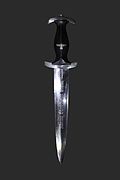162:
143:
174:
20:
131:
142:
80:
were often also crafted in a horizontally. After 1550, the Swiss dagger became a prestigious ornamental weapon, with hilt and sheath decorated with precious metal and scenes from the Bible, classical antiquity or Swiss history. Daggers of this period are also referred to as "Holbein" daggers.
64:
The curved shape of the Swiss dagger hilt appeared as early as the 13th century and remained peculiar to
Switzerland, and does not appear to have been imitated elsewhere. The blade was characteristically double edged, tapering to a point and usually had a diamond shape cross-section.
85:, in the early 17th century. Schneider (1977) compiled a full index of all known originals and copies (including a considerable number of 19th-century imitations forgeries), for a total of 156 specimens. Many copies of originals were made in the period of
154:
from 14th-century
Switzerland, showing the characteristic curved guard-pieces of the later Swiss dagger, but the curvature of the two pieces is parallel, while the classical Swiss dagger has opposite curvature as it were "enveloping" the
93:. Schneider was able to distinguish copies from originals due to a slight shrinking due to the casting process. His conclusion was that only slightly less than half of the extant "Holbein" daggers are originals.
173:
311:
dated sheaths according to
Schneider (1977): 1563 (no. 80), 1564 (79), 1565 (33), 1567 (16, 17), 1569 (27, 129), 1572 (113), 1573 (119), 1581 (43a), 1582? (97), 1585 (19,94), 1592 (58).
161:
76:
on the sheath of such a dagger (which was implemented on a number of surviving examples). The dagger was often worn horizontally on the hip, thus the ornaments on the
57:
which were in use during the 14th and 15th centuries. The characteristic mark of the Swiss dagger are two crescent-shaped, inward-bent metal bars delimiting the
81:
Schneider (1977) dates the bulk of the extant specimens of this ornamented type to the 1560s to 1570s. The Swiss dagger disappears with the beginning
130:
116:
formations) were also modeled on the Swiss dagger. In the Swiss army, the dagger was removed from the officers' dress uniform in 1995.
368:
Der
Schweizerdolch, Waffen- und Kulturgeschichtliche Entwicklung mit vollständiger Dokumentation der bekannten Originale und Kopien
282:
359:
298:
412:
402:
113:
324:
375:
386:
192:
69:
44:
90:
219:
86:
8:
292:
97:
253:
E. A. Gessler, 'Eine
Schweizer Dolchscheide mit der Darstellung des Totentanzes', in:
278:
48:
407:
197:
19:
381:
268:
229:
214:
352:
346:
340:
109:
82:
396:
180:
73:
101:
234:
51:
during the 16th century. It develops from similar dagger types known as
104:, the hilts of some political and military daggers (worn by members of
100:
beginning in 1943 was modeled after the historical Swiss dagger. In
224:
150:
77:
53:
274:
24:
40:
372:
136:
Swiss dagger of the "Holbein" type in the style of c. 1570.
58:
167:
The 1914 ordnance dagger of the officers of the Swiss army
187:
105:
255:
270:
Hans
Holbein the Younger: The Basel Years, 1515-1532
353:
394:
347:
341:
23:Swiss dagger, early 16th century, found in the
96:The ordnance dagger issued to officers in the
16:Dagger used by Swiss mercenaries, 16th century
18:
395:
383:Rapport annuel / Musée National Suisse
266:
370:, Zurich (1977); review: B. Thomas,
360:Historical Dictionary of Switzerland
13:
14:
424:
260:
172:
160:
141:
129:
314:
305:
247:
1:
297:: CS1 maint: date and year (
240:
7:
208:
68:One of the masterpieces of
39:) is a distinctive type of
10:
429:
267:Müller, Christian (2006).
186:, ordnance dagger of the
121:Examples of Swiss daggers
89:(19th century), using a
70:Hans Holbein the Younger
413:Renaissance-era weapons
72:is a 1521 design for a
335: Franz Egger:
321:Revue Militaire Suisse
193:Meine Ehre heißt Treue
28:
403:Old Swiss Confederacy
220:Swiss arms and armour
22:
87:national Romanticism
257:39 (1930), 82-96.
98:Swiss Armed Forces
29:
284:978-3-7913-3580-3
49:Swiss mercenaries
420:
366:Hugo Schneider,
355:
349:
343:
328:
318:
312:
309:
303:
302:
296:
288:
264:
258:
251:
176:
164:
145:
133:
428:
427:
423:
422:
421:
419:
418:
417:
393:
392:
332:
331:
319:
315:
310:
306:
290:
289:
285:
277:. p. 314.
265:
261:
252:
248:
243:
230:Medieval dagger
215:List of daggers
211:
206:
205:
204:
201:
177:
168:
165:
156:
146:
137:
134:
123:
122:
17:
12:
11:
5:
426:
416:
415:
410:
405:
391:
390:
379:
364:
357:in the online
337:Schweizerdolch
330:
329:
313:
304:
283:
259:
245:
244:
242:
239:
238:
237:
232:
227:
222:
217:
210:
207:
203:
202:
178:
171:
169:
166:
159:
157:
147:
140:
138:
135:
128:
125:
124:
120:
119:
118:
91:casting method
83:Baroque period
74:dance of death
37:Schweizerdolch
15:
9:
6:
4:
3:
2:
425:
414:
411:
409:
406:
404:
401:
400:
398:
388:
384:
380:
377:
373:
369:
365:
362:
361:
356:
350:
344:
338:
334:
333:
326:
322:
317:
308:
300:
294:
286:
280:
276:
272:
271:
263:
256:
250:
246:
236:
233:
231:
228:
226:
223:
221:
218:
216:
213:
212:
200:on the blade.
199:
195:
194:
189:
185:
184:
175:
170:
163:
158:
153:
152:
144:
139:
132:
127:
126:
117:
115:
111:
107:
103:
99:
94:
92:
88:
84:
79:
75:
71:
66:
62:
60:
56:
55:
50:
46:
42:
38:
34:
26:
21:
382:
371:
367:
358:
336:
323:147 (2002),
320:
316:
307:
269:
262:
254:
249:
196:inscription
191:
182:
149:
102:Nazi Germany
95:
67:
63:
52:
36:
33:Swiss dagger
32:
30:
387:85–94
385:39 (1930),
374:35 (1978),
235:Swiss degen
198:acid etched
45:Switzerland
397:Categories
241:References
183:Ehrendolch
293:cite book
225:Baselard
209:See also
78:scabbard
43:used in
408:Daggers
354:Italian
275:Prestel
190:, with
47:and by
25:Thielle
348:French
342:German
281:
151:basler
112:, and
54:basler
41:dagger
27:river.
376:198f.
325:p. 33
155:hand.
351:and
339:in
299:link
279:ISBN
179:The
114:NSKK
59:hilt
31:The
181:SS-
148:A
399::
345:,
295:}}
291:{{
273:.
188:SS
110:SA
108:,
106:SS
61:.
389:.
378:.
363:.
327:.
301:)
287:.
35:(
Text is available under the Creative Commons Attribution-ShareAlike License. Additional terms may apply.




